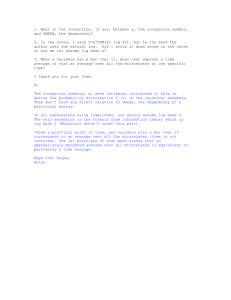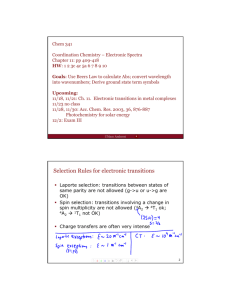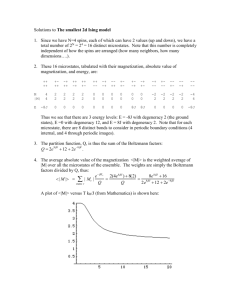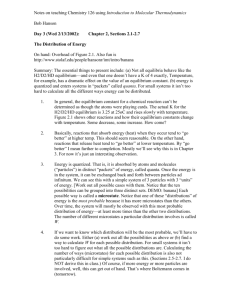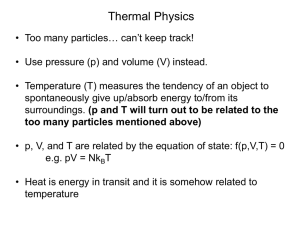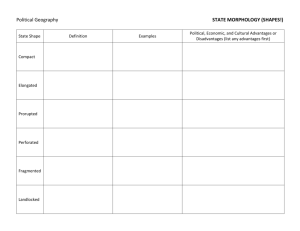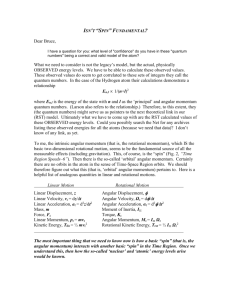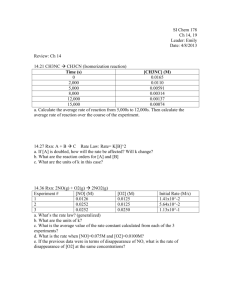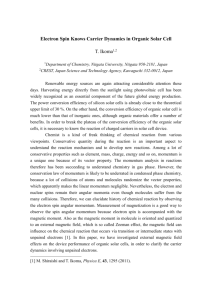Russell-Saunders Term Symbols
advertisement
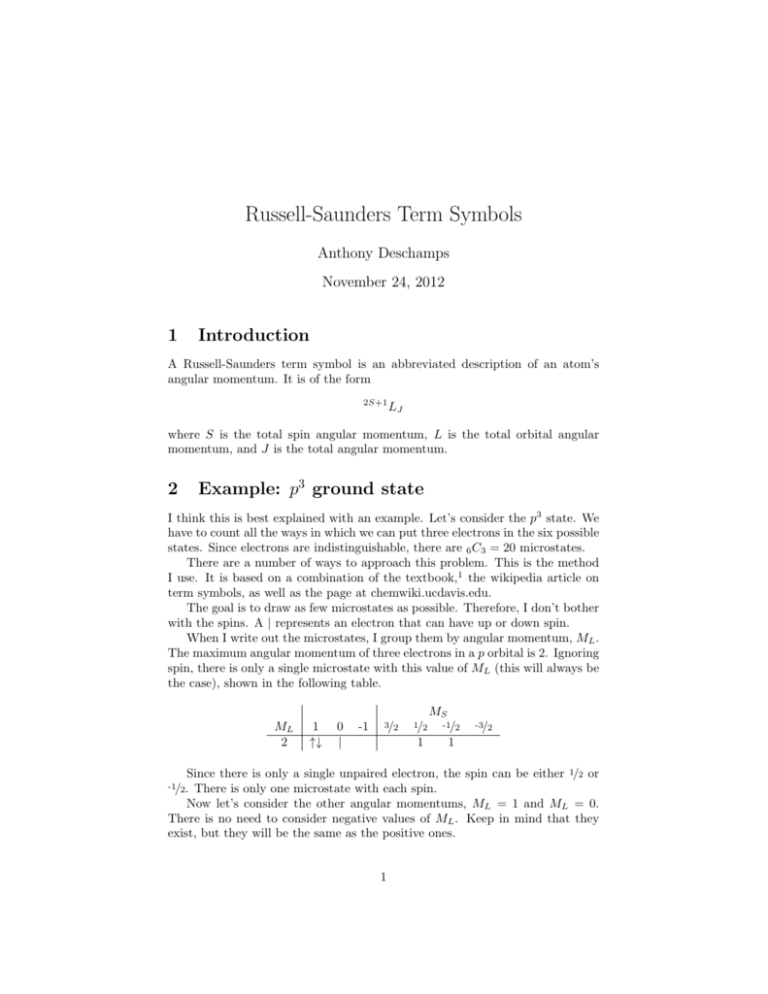
Russell-Saunders Term Symbols Anthony Deschamps November 24, 2012 1 Introduction A Russell-Saunders term symbol is an abbreviated description of an atom’s angular momentum. It is of the form 2S+1 LJ where S is the total spin angular momentum, L is the total orbital angular momentum, and J is the total angular momentum. 2 Example: p3 ground state I think this is best explained with an example. Let’s consider the p3 state. We have to count all the ways in which we can put three electrons in the six possible states. Since electrons are indistinguishable, there are 6 C3 = 20 microstates. There are a number of ways to approach this problem. This is the method I use. It is based on a combination of the textbook,1 the wikipedia article on term symbols, as well as the page at chemwiki.ucdavis.edu. The goal is to draw as few microstates as possible. Therefore, I don’t bother with the spins. A | represents an electron that can have up or down spin. When I write out the microstates, I group them by angular momentum, ML . The maximum angular momentum of three electrons in a p orbital is 2. Ignoring spin, there is only a single microstate with this value of ML (this will always be the case), shown in the following table. MS ML 2 1 ↑↓ 0 | -1 3/2 1/2 -1/2 1 1 -3/2 Since there is only a single unpaired electron, the spin can be either 1/2 or There is only one microstate with each spin. Now let’s consider the other angular momentums, ML = 1 and ML = 0. There is no need to consider negative values of ML . Keep in mind that they exist, but they will be the same as the positive ones. -1/2. 1 MS ML 1 total 0 1 ↑↓ | 0 ↑↓ | | -1 | 3/2 1/2 -1/2 -3/2 | 1 1 1 2 3 1 1 2 3 1 If we have n unpaired electrons in a microstate, then the number of ways to arrange the spins is determined using combinations - that is, by the nth row of Pascal’s triangle. For example, with three unpaired electrons, there are 1, 3, 3, and 1 ways of making the total spin 3/2, 1/2, -1/2, and -3/2 respectively. The advantage of writing out states without specifying the spins is that there are 2n different spins for each state with n unpaired electrons. In the example above, we took care of 8 microstates in a single line for ML = 0. Now we construct a table with ML on the side and MS along the top. The textbook lists all the configurations in the table. I don’t like this, because it can result in a very large table. It’s really only neccessary to list how many microstates correspond to a given ML and MS . MS ML (D) 2 (P) 1 (S) 0 -1 -2 3/2 1/2 -1/2 -3/2 1 1 2 3 2 1 1 2 3 2 1 1 To check that you counted all the microstates, add up all these numbers and make sure they are consistent with what you calculated at the beginning. In this case, we have 20 microstates. However, it is not really necessary to construct the bottom half of the table, since it will be identical to the top. The largest value of ML is 2, corresponding to a D state. The largest value of MS for ML = 2 is 1/2, which gives us a doublet (2S + 1). We’ll leave this as a 2 D, and come back to the subscripts later. For now, we eliminate all the microstates we just used for the 2 D term: MS ML (D) 2 (P) 1 (S) 0 MS 3/2 1/2 -1/2 -3/2 1 1 2 3 1 2 3 1 ML → (D) 2 (P) 1 (S) 0 3/2 1/2 -1/2 -3/2 1 1 2 1 2 1 Now we do the same thing again. The maximum ML is 1 with MS = 1/2, which gives us a doublet P state, 2 P . Lastly we have ML = 0 and MS = 3/2, which gives us a 4 S term. 2 MS ML (P) 1 (S) 0 MS 3/2 1/2 -1/2 -3/2 1 1 2 1 2 1 ML → (P) 1 (S) 0 3/2 1/2 -1/2 -3/2 1 1 1 1 We found three terms for the p3 state: 2 D, 2 P , and 4 S. The subscript J takes values from L + S to |L − S|. For 2 D, L = 2 and S = 1/2. Therefore, J = 5/2, 3/2, so the full terms are 2 D5/2 and 2 D3/2 . The other terms are 2 P3/2 and 2 P1/2 , as well as 4 S3/2 and 4 S1/2 . I would recommend practicing this. The term symbols for the s, p, and d ground states are given on page 472 in the McQuarrie text.1 Especially, try the d configurations, keeping in mind that it is okay for a term to occur multiple times. 3 Example: p3 s1 excited state The ground state of oxygen is 2p4 , so 2p3 3s1 is an excited state (I’m not sure if this is spin-forbidden, but it’s okay - we can still use it an example). Determining term symbols for excited states is exactly the same. The main difference is that when you have two unfilled orbitals, there can be quite a few more microstates. For the s1 p3 configuration, there are 2 ways to put an electron in an s orbital, and 6 C3 = 20 combinations for the p orbital, giving a total of 40 microstates. When we deal with d orbitals, the number of microstates can be very large. As another example, we’ll determine the term symbols for the s1 p3 state. The maximum ML is 2 ML 2 1 ↑↓ total 1 L 0 | | -1 1 MS 0 -1 1 2 1 1 2 1 1 2 1 1 2 1 2 4 2 1 4 6 4 1 1 4 6 4 1 2 | ↑↓ | total 0 | | | ↑↓ | | | total -2 The summary table is below. Check that we counted all the microstates, keeping in mind that the rows for ML = −1, −2 are implied. 3 ML 2 1 0 2 1 MS 0 2 4 6 1 1 2 4 -1 1 2 4 -2 1 I’ll finish this later. . . The term symbols, ignoring the subscripts, are 3 D, 1 D, 3 P , 1 P , 5 S, and 3 S. The full term symbols are 3 D3 , 3 D2 , 3 D1 , 1 D2 , 3 P2 , 3 P1 , 3 P0 , 1 P1 , 5 S2 , 5 S1 , 5 S0 , 3 S1 , and 3 S0 . References [1] D.A. McQuarrie. Quantum chemistry. Univ Science Books, 2008. 4
